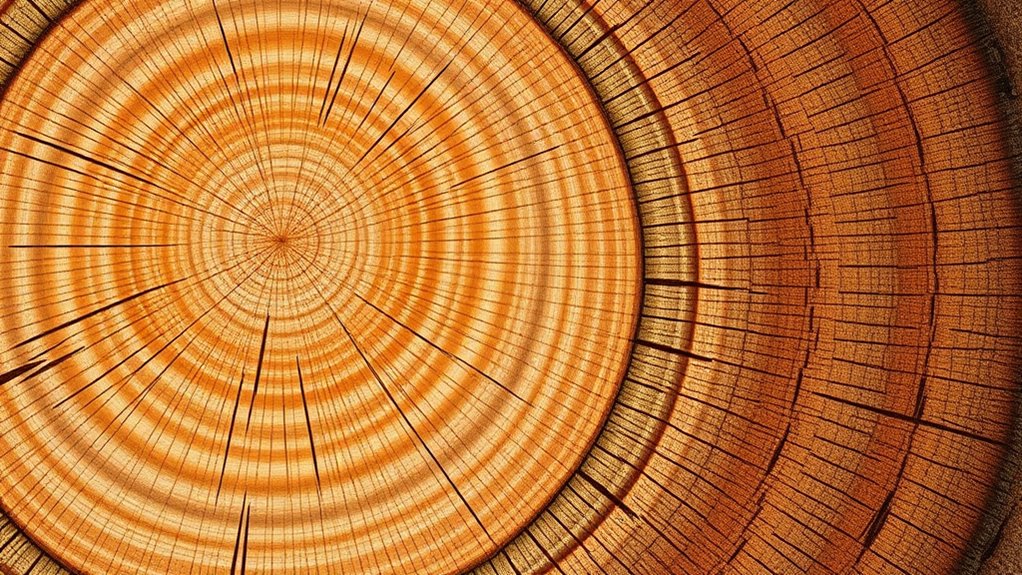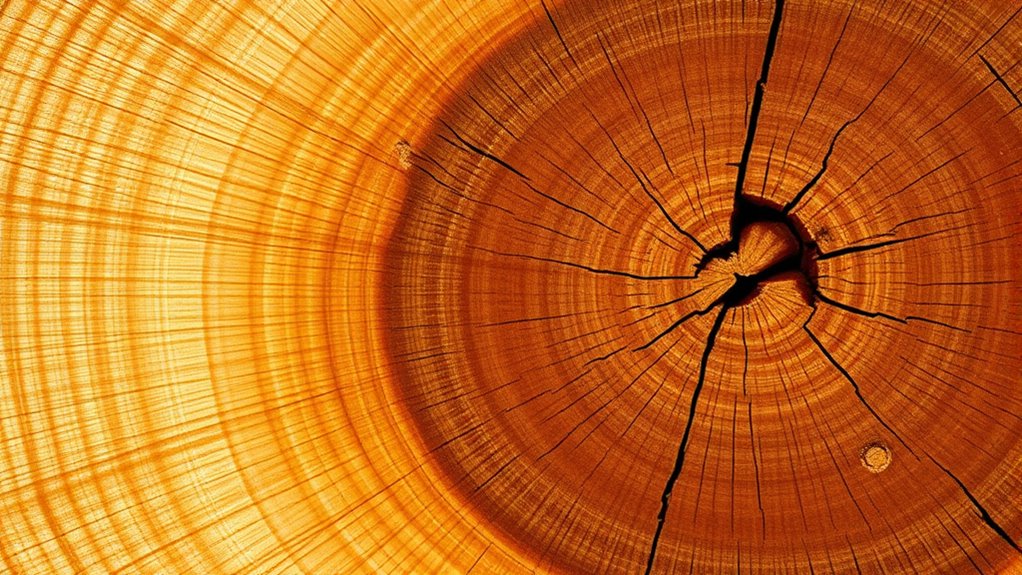To spot the differences between sapwood and heartwood, look for color and firmness. Sapwood is usually lighter, softer, and more permeable, while heartwood is darker, denser, and less absorbent. You may notice growth rings or test decay resistance to tell them apart. Recognizing these traits helps you select the right wood for durability and strength. Keep exploring these details to make smarter choices in your woodworking or forestry projects.
Key Takeaways
- Sapwood is lighter in color, softer, and more permeable compared to darker, denser heartwood.
- Heartwood contains tannins and resins, making it more resistant to pests, decay, and moisture.
- Look for color differences and distinct growth rings to distinguish between the two layers.
- Sapwood shows active water transport, often appearing fresher or paler; heartwood appears older and more solid.
- Resistance to decay and permeability tests can help identify heartwood versus sapwood.

While both sapwood and heartwood are indispensable parts of a tree’s structure, they serve different functions and have distinct characteristics. Recognizing these differences is essential if you’re interested in forest sustainability and wood preservation. Sapwood is the outer, living layer of a tree’s trunk, responsible for transporting water and nutrients from the roots to the leaves. It’s typically lighter in color, often pale or whitish, and contains active cells that facilitate this critical flow. Because sapwood is alive and actively functioning, it remains more susceptible to pests, fungi, and decay, which can compromise the tree’s health if not managed properly. Proper identification of these layers can also influence home maintenance and woodworking decisions, ensuring better durability and longevity of wood products.
Sapwood is the living, lighter outer layer of a tree, vital for water transport but more susceptible to pests and decay.
On the other hand, heartwood forms the inner core of the tree. It’s composed of older, non-living cells that have ceased to transport water. Over time, as the tree ages, the heartwood develops a darker hue—ranging from deep brown to reddish tones—due to the accumulation of secondary compounds like tannins and resins. These substances make the heartwood more resistant to decay and pests, which is why it’s often prized in woodworking and construction. Knowing how to distinguish between sapwood and heartwood is fundamental for wood preservation efforts, as the durability of the final product depends markedly on the presence of heartwood.
If you’re involved in sustainable forestry or using wood for construction, understanding these differences helps you make informed decisions that support forest sustainability. For example, selecting heartwood for outdoor furniture or structural elements ensures longer-lasting results, reducing the need for chemical treatments and frequent replacements. Properly harvested trees with a high proportion of heartwood also contribute to responsible resource use, as they maximize the utility of each tree while maintaining healthy forests through selective harvesting practices.
From a practical standpoint, spotting sapwood and heartwood isn’t complicated once you know what to look for. Sapwood appears lighter and more permeable, often with a softer texture, while heartwood is darker, denser, and more resistant to moisture. If you’re examining a piece of wood, look for color differences, growth rings, or even test its resistance to decay. This knowledge is especially helpful when choosing wood for preservation projects or when assessing the quality of timber to ensure it aligns with sustainable practices and durability standards.
Frequently Asked Questions
Can Sapwood Turn Into Heartwood Over Time?
Yes, sapwood can turn into heartwood over time during tree aging. As the tree ages, the outer layers of sapwood undergo a wood conversion, becoming more resistant to decay and filled with deposits like resins and tannins. This process transforms the active, living sapwood into the non-living, darker heartwood. So, with time, the wood naturally transitions, giving trees their characteristic core and outer layers.
Are Certain Wood Species More Likely to Have Distinct Sapwood and Heartwood?
Think of the tree as a storybook, where certain species variation creates vivid chapters. Some woods exhibit a striking visual contrast between sapwood and heartwood, making their differences more noticeable. You’ll find that hardwoods like oak and walnut often showcase clear distinctions, acting as symbols of resilience and maturity. So, yes, specific species are more likely to display prominent sapwood and heartwood, highlighting the unique character etched into each timber.
How Does Moisture Content Affect Sapwood and Heartwood Identification?
Moisture content considerably affects how you identify sapwood and heartwood. When moisture levels are high, sapwood appears lighter and wetter, making it easier to distinguish from drier, darker heartwood. As wood ages, moisture content decreases, causing sapwood to dry out and blend more with heartwood. This change can make identification trickier over time, especially if the wood has been exposed to fluctuating moisture levels.
Is Heartwood More Resistant to Pests Compared to Sapwood?
Yes, heartwood is more resistant to pests compared to sapwood because it has better pest resistance and increased wood durability. You’ll notice that pests find it harder to penetrate and infest heartwood due to its chemical composition and density. This natural pest resistance makes heartwood a preferred choice for long-lasting, durable wood applications, especially where pest attack risk is high. So, always consider heartwood for enhanced durability and pest resistance.
Can Artificial Treatments Alter the Appearance of Sapwood or Heartwood?
Sure, artificial treatments can totally change the look of sapwood or heartwood. You might think they’re natural, but dyeing techniques and surface coatings can make these woods appear dramatically different. Ironically, what’s supposed to preserve or enhance their beauty often masks their true nature. So yes, with a bit of dye or a coat, you can easily alter their appearance, making it hard to tell what’s real or artificially enhanced.
Conclusion
Understanding the differences between sapwood and heartwood helps you see trees as more than just wood; they’re symbols of life’s duality. Sapwood, like fresh beginnings, carries vitality and potential, while heartwood stands as a proof of resilience and history. Recognizing these layers allows you to appreciate nature’s silent stories, reminding you that growth and endurance coexist within every tree—and within you. Embrace these contrasts, and find strength in their silent dialogue.









